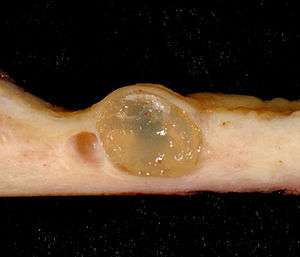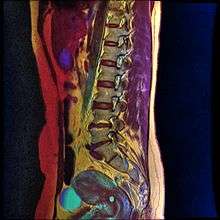Nabothian cyst
| Nabothian cyst | |
|---|---|
 | |
| Nabothian cyst | |
| Classification and external resources | |
| Specialty | Obstetrics gynecology |
| ICD-10 | N88.8 |
| ICD-9-CM | 616.0 |
| DiseasesDB | 32596 |
| MedlinePlus | 001514 |
A nabothian cyst (or nabothian follicle)[1] is a mucus-filled cyst on the surface of the cervix. They are most often caused when stratified squamous epithelium of the ectocervix (toward the vagina) grows over the simple columnar epithelium of the endocervix (toward the uterus). This tissue growth can block the cervical crypts (subdermal pockets usually 2–10 mm in diameter), trapping cervical mucus inside the crypts.
Presentation
Nabothian cysts appear most often as firm bumps on the cervix's surface. A woman may notice the cyst when inserting a diaphragm or cervical cap, or when checking the cervix as part of fertility awareness.[2] A health care provider may notice the cysts during a pelvic exam.
Prognosis, treatment, and associated conditions

Nabothian cysts are considered harmless and usually disappear on their own,[2] although some will persist indefinitely. Some women notice they appear and disappear in relation to their menstrual cycle. If a woman is not sure the anomaly she has found on her cervix is a nabothian cyst, a visit to a doctor is recommended to rule out other conditions.[2]
Rarely, nabothian cysts have a correlation with chronic cervicitis, an inflammatory infection of the cervix.
Nabothian cysts are not considered problematic unless they grow very large and present secondary symptoms. A physician may wish to perform a colposcopy or biopsy on a nabothian cyst to check for cancer or other problems. Two methods for removing these cysts include electrocautery and cryofreezing, although new cysts may form after the procedure.
Eponym
Nabothian cysts are also known as nabothian follicles, mucinous retention cysts, or epithelial inclusion cysts. They are named after German anatomist Martin Naboth (1675-1721), who wrote about them in a 1707 treatise titled De sterilitate mulierum. However, they were earlier described by French surgeon Guillaume Desnoues (1650-1735).[3] Since it is a derived term, nabothian is not spelled with a capital first letter.
See also
References
- ↑ "Dorlands Medical Dictionary:nabothian follicles".
- 1 2 3 Weschler, Toni (2002). Taking Charge of Your Fertility (Revised ed.). New York: HarperCollins. pp. 227–228, 330. ISBN 0-06-093764-5.
- ↑ "Nabothian Cysts". Who Named It?. 2007. Retrieved 2007-06-22.